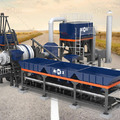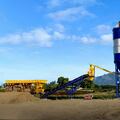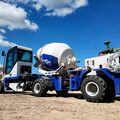When considering concrete pump solutions for any construction project, it's crucial to take into account several factors to ensure efficiency, cost-effectiveness, and overall project success. Concrete pump solutions are essential for transporting concrete to hard-to-reach areas, improving the quality of work, and speeding up the process. Selecting the right solution is dependent on various factors such as project requirements, types of pumps, site conditions, and other logistical considerations. Let’s dive into the main factors to consider when choosing the best concrete pump solutions for your construction needs.

Type of Concrete Pump
The first factor to consider when choosing concrete pump solutions is the type of pump best suited for your project. There are two primary types of pumps:
Boom Pumps: Boom pumps are typically used in large-scale projects where concrete needs to be placed at heights or over long distances. These pumps have a hydraulic arm (boom) that can reach over obstacles like buildings or reach higher stories of a structure. Boom pumps are excellent for high-rise constructions, large bridges, or urban development projects where space might be limited.
Line Pumps (Trailer Pumps): Line pumps are versatile and are often used for smaller projects or projects where concrete needs to be pumped horizontally. A line pump transports concrete through hoses or steel pipes laid out on the ground. These pumps are generally more flexible and can be moved around the site easily.
Understanding the nature of your project will help determine which type of pump is most suitable. For large and complicated projects, boom pumps are ideal, while for smaller or more versatile applications, line pumps may be better.
Concrete Pump Capacity
Another important factor in selecting concrete pump solutions is the capacity of the pump. This refers to the volume of concrete the pump can move per hour. Typically, pumps come with a variety of capacities, ranging from smaller units that pump a few cubic meters per hour to large industrial pumps that can handle more than 100 cubic meters per hour.
The choice of pump capacity depends on:
Project Size: Larger projects with tight deadlines may require higher-capacity pumps to ensure that enough concrete is delivered in a timely manner.
Concrete Mix Type: Some types of concrete mix, such as high-strength or fiber-reinforced concrete, can be more challenging to pump. Ensure the chosen pump has the required power to handle the specific mix.
Site Layout and Logistics: If the site is difficult to access, you may need a smaller, more portable pump that can navigate tight spaces while still providing adequate capacity.
Concrete Pump Reach
Another key aspect of concrete pump solutions is the reach of the pump. This refers to how far horizontally and vertically the pump can deliver concrete. This factor is particularly important for projects with hard-to-reach areas, high elevations, or long distances between the concrete mixer and the pour site.
Vertical Reach: Projects such as high-rise buildings or elevated structures will need pumps with a long vertical reach. Boom pumps with long hydraulic arms are typically used in such scenarios to ensure that concrete can be poured at higher levels.
Horizontal Reach: If the construction site is spread out over a large area, the horizontal reach of the pump will be essential. In cases where the pump is stationary and needs to deliver concrete over long distances, both the type of pump and the length of the hoses or pipes come into play.
Carefully assessing the reach required by your project will help ensure that the concrete pump you select is capable of delivering concrete where it’s needed without wasting time on manual labor.
Site Accessibility and Mobility
The accessibility and mobility of the construction site is a major factor in determining the appropriate concrete pump solutions. Some sites are easy to navigate, while others may present challenges such as narrow access roads, uneven terrain, or the need to maneuver around obstacles like existing buildings or structures.
Mobile Pumpcrete Solutions: If your site is challenging to access or constantly changing, mobile pumpcrete options, like a boom pump on a truck, might be the best fit. These mobile pumps can be easily transported from one part of the site to another.
Stationary Pump Solutions: In contrast, if your project has a fixed pouring area, a stationary concrete pump solution may be more appropriate. These pumps are typically trailer-mounted and can be parked in one location for continuous concrete delivery.
Site conditions must be carefully analyzed to determine whether mobile or stationary concrete pump solutions are more efficient for your project.
Concrete Pump Power Source
The power source of a concrete pump is another critical factor to consider. Concrete pumps are generally powered by either diesel or electric engines.
Diesel Concrete Pumps: Diesel-powered pumps are highly versatile because they can work in remote areas where there is no reliable access to electricity. They offer high power output and are ideal for large projects, heavy-duty work, or rural locations.
Electric Concrete Pumps: Electric-powered pumps are more eco-friendly and cost-efficient when electricity is readily available. They are typically quieter and produce fewer emissions, making them suitable for urban areas or indoor construction projects.
When selecting a concrete pump solution, it is important to consider the availability of power sources at your site and the environmental impact of your choice.
Cost Considerations
Cost is a major factor when selecting concrete pump solutions. The price of concrete pumps varies significantly depending on the type, capacity, brand, and features of the equipment.
Initial Investment: While high-capacity pumps or boom pumps might have a higher upfront cost, they can offer faster work rates, thereby reducing labor costs in the long run.
Operational Costs: Consider the fuel or electricity costs associated with running the pump, as well as the maintenance expenses. Diesel-powered pumps may have higher fuel costs, while electric pumps may require specific voltage requirements on-site.
In addition to the cost of the pump, you should also budget for any additional accessories or hoses that may be needed to achieve the desired reach.
Maintenance and Durability
Maintenance and durability are vital considerations in choosing the right concrete pump solution. A high-quality concrete pump should be built to last, with a robust design that can withstand the demands of construction work. Regular maintenance is key to ensuring the longevity of the equipment and minimizing costly downtime.
Durability: Choose a pump that is constructed from high-quality materials and has a solid reputation for durability. Pumps designed for rough terrain or harsh conditions, such as those in the mining or heavy industrial sectors, are often more durable.
Maintenance Needs: Some pumps require more frequent maintenance than others. Consider the availability of spare parts, ease of repairs, and whether the manufacturer offers after-sales support for maintenance.
A concrete pump solution that requires less frequent maintenance will result in less downtime, ensuring that your project stays on track.
Selecting the right concrete pump solutions involves a careful consideration of several factors, including the type of pump, capacity, reach, site accessibility, power source, cost, and durability. By taking all of these into account, you can ensure that you choose the best pump solution to meet the specific needs of your construction project. With the right concrete pump solution in place, you can improve efficiency, save time, and ensure the success of your project.





